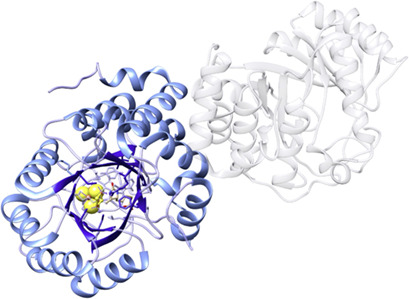Journal list menu
Export Citations
Download PDFs
Table of Contents
Anaerobic Radical Enzymes for Biotechnology
- First Published: 26 April 2018

Radicals offer the possibility of unique and efficient chemical transformations, if properly controlled. Nature can provide this control in the form of enzymes, and this review provides an overview of the types of enzymes characterized so far, their current applications in biotechnology, and future directions to better exploit these fascinating catalysts.
Minireview: A Comeback of Hg-Derivatives in Protein Crystallography with Cys-Modification
- First Published: 25 February 2015

Nowadays, identification of the active-site motif in a new enzyme is highly possible through sequence alignment and comparison. Although the active site is usually secured in a well-formed pocket, it is also accessible to externally added reagents. By mutating an active-site residue into cysteine, chances of obtaining useful Hg-derivatives for crystal structure determination are greatly increased.
Characterization and Inhibition of the Main Protease of Severe Acute Respiratory Syndrome Coronavirus
- First Published: 25 February 2015

Severe acute respiratory syndrome (SARS)-associated coronavirus (CoV) has disappeared, but might re-emerge in the future, together with other new and existing CoV. The 3CL protease of SARS-CoV, a key enzyme for viral replication, is a promising drug target for inhibitor molecules in order to combat CoVs. This review summarizes current developments and research on inhibitors against proteases and the engineering of the mutant protease as an endopeptidase.
Biotechnological Production of Astaxanthin through Metabolic Engineering of Yeasts
- First Published: 25 February 2015

As a highly sought carotenoid with wide applications, the growing market demand for bio-derived astaxanthin, and the insufficient efficiency of astaxanthin biosynthesis drive the advances in metabolic engineering of native astaxanthin producers and heterologous hosts. Recent research progresses in metabolic engineering of astaxanthin biosynthesis by yeasts are reviewed and possible future strategies proposed.
Heat- and Alkaline-Stable Xylanases: Application, Protein Structure and Engineering
- First Published: 10 March 2015

The extremophilic xylanases are the key enzymes in the degradation of the polysaccharide xylan and have been applied as bio-catalysts in a wide variety of hemicellulose- and cellulose-based industries. Here, the latest developments of alkaline-stable and heat-stable xylanases are discussed in order to better understand their catalytic mechanisms and provide an engineering basis.
Rational Design to Improve Protein Thermostability: Recent Advances and Prospects
- First Published: 11 March 2015
Current Progresses in Phytase Research: Three-Dimensional Structure and Protein Engineering
- First Published: 09 January 2015

The utilization of phytase has provided great beneficial effects by increasing the nutritional values of animal feeds and reducing the supplementation of inorganic phosphorus. To gain insight into the molecular mechanism of phytases through three-dimensional protein structures is an intense area of research. In this review, the up-to-date status of phytase structural and engineering studies is summarized.
Production of Tailor-Made Enzymes for Detergents†
- First Published: 12 February 2014

Enzymes in detergents, optimized by genetic engineering, remove natural stains by forming complexes with the substrates (stains) and hydrolyze them. Industrial production of the enzymes takes place in fermenters 40 to 125 m3 in size. Products are coated granules and liquids. The challenges of safe manufacture of large quantities of enzymes are explained.
Enzymatic Synthesis of Tertiary Alcohols†
- First Published: 12 February 2014

Tertiary alcohols are an important functionality in many active pharmaceuticals and fine chemicals. Biotechnological processes are therefore required to synthesize the alcohols in high yields and enantiomeric purity; however, generally applicable methods are lacking so far. Already identified enzymatic methods are presented and their advantages and disadvantages are discussed with a view to possible applications.
Current Developments in Cellulase Engineering†
- First Published: 12 February 2014

Efficient cellulose degradation is essential for the production of biofuels from renewable sources. This review discusses the results from recent years in the field of cellulase engineering, highlighting both achievements and limitations. The focus is on designer cellulosomes and strategies to increase the stability and activity of cellulases.






